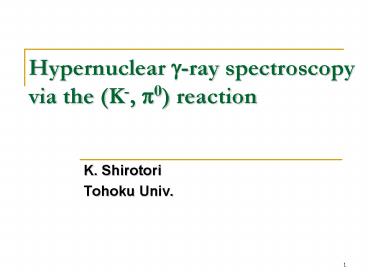Hypernuclear g-ray spectroscopy via the (K-, p0) reaction PowerPoint PPT Presentation
Title: Hypernuclear g-ray spectroscopy via the (K-, p0) reaction
1
Hypernuclear g-ray spectroscopy via the (K-, p0)
reaction
- K. Shirotori
- Tohoku Univ.
2
Motivation
- Mirror hypernuclei
- Neutron-rich hypernuclei
- sd-shell hypernuclei
3
Mirror hypernuclei
- Charge symmetry breaking in hypernuclei
- ?Systematic data by precise measurement by g ray
spectroscopy - Target
- 4He 4LH ? 4LHe
- 12C 12LB ? 12LC
4
Neutron-rich hypernuclei
- 7LHe
- Disappearance of neutron-halo
Drastic B(E2) change
6He
7LHe
E2
Calc. by E. Hiyama
5
sd-shell hypernuclei
- Even-even core hypernuclei
- Even-even core B(E2) transition 4? 2, 2?0
- ? Moment of inertia ErotI(I1)/2J
E(4)
4
E(4)/ E(2) 3.3 Rotation 2.0 Vibration
E2
E(2)
2
E2
Small Eg
0
Large Eg
- The energy of those transition has the
information of the nuclear deformation/collectivit
y. - Energy spacing and B(E2) measurement
- ?Effects of L on the collective motion
6
Even-even core hypernuclear production-Advantages
of the (K-, p0) reaction-
- (K-, p-) reaction (NCX)
- Difficult to produce hypernuclei with even-even
core - Direct 25Mg(10), 29Si(4.7) enrich target
- ?Hyperfragment (need unique identification method
and how about DSAM difficulty ?) - (K-, p0) reaction (SCX)
- Possible direct production
- ?Systematic study of 2?0 transition
- 23Na(23LNe), 27Al(27LMg), 31P(31LSi),
- 35,37Cl(35,37LS), 39K(39LAr), 45Sc(45LCa)
4?2?0 of core nuclei
7
Experiment
8
Past experiment BNL E907
NMS
- 12LB reaction spectroscopy via the (K-stop, p0)
reaction - NMS
- Neutral Meson Spectrometer
- Pre-shower BGO detector
- Shower tracking DC
- CsI calorimeter
- DEmass 2.2 MeV (12LB g.s)
p0 energy spectrum
M. W. Ahmed et al
9
Requirements of the (K-, p0) reaction spectroscopy
- Mass resolution A few MeV _at_ E1E2
- Position resolution and Vertex resolution
- Energy resolution by measuring opening angle
- Doppler correction
- Angular selection
- qlt 5(DL 0) substitutional states ?
Hyperfragment - qgt 515(DL 1 or 2) bound states ?s, p,
sd-shell - Spin-flip cross section at large angles (q gt10)
- Good efficiency
- To keep large production rate (/beam) order of
mb
10
Detector type
- Size Beam momentum
- 0.9, 1.1, 1.5, 1.8 GeV/c ?
- Energy resolution
- Inorganic-scintillator CsI
- Position resolution
- With position detector ?
- Homogeneous inorganic-scintillator
- OR
- Inorganic-scintillator with position detectors
SCISSORS III _at_ LNS
11
Beam momentum
- Large production
- 0.9 GeV/c or 1.8 GeV/c
- Spin-flip and non-spin-flip
- 1.1 GeV/c or 1.5 GeV/c
- ? K1.1 or K1.8 ?
- Deeply-bound for sd-shell K1.8
- Both NCX and SCX with spin-flip K1.1
- ?Both K1.1 and K1.8 are available.
12
Acceptance of both two decay g rays
- No large difference by changing the beam momentum
- Hit position of two g rays are averaged within p0
scattering angles. - The size of detector cannot be optimized to each
beam momentum. - The detector can be used at both K1.1 and K1.8.
- 1.1 GeV/c - 1.5 GeV/c - 1.8 GeV/c
qlt10o
10oltqlt25o
g-ray hit position on the detector _at_
E1-E2/(E1E2) lt0.3 (1 m from the target, w/o
the angular correlation of the cross section)
Size 1000 mm1000 mm (with beam through hole)
13
Detector thickness
Energy deposit of both two g rays from the p0 of
1.0 GeV/c.
15X0 280 mm
- The simulation shows that the thickness of
detector is needed to be more than 20X0 by using
the CsI crystal. - CsI X0 18.6 mm
- The scattered p0 has large energy because the (K,
p) reaction is the endoergic reaction.
20X0 370 mm
25X0 470 mm
30X0 560 mm
Thickness 300400 mm
35X0 650 mm
14
Choice of detector type
- Large target size
- Wide scattering angle
- ?Homogeneous crystal colorimeter
- Shower Tracker ?(to determine the precise
position) - Pre-shower detector
- Converter BGO, PWO
- ? Tracker DC
- ? Calorimeter CsI
- Segmented target sandwiched by scintillation
counter - ?Need to study
Charge veto
Crystal
Hole
g
Hyperball-J (half)
g
SksMinusSks?
K-
50 cm
Rough setup figure
Cost of the crystal 1 cm3/5 ? 100 cm100
cm40 cm 4105 cm3 ? \ 2.4108 _at_ 1 \120
15
Future plan
- Detector type selection
- Homogeneous crystal Vertex resolution ?
- Pre-shower tracker Efficiency ?
- Target segmentation
- Realistic simulation
- Vertex resolution
- Energy resolution
- Doppler correction
- Background estimate
- Trigger, DAQ ..
16
Summary
- Purposes of g-ray spectroscopy via the (K-, p0)
reaction - Mirror hypernuclei Charge symmetry breaking
- neutron-rich hypernuclei Disappearance of
neutron-halo - sd-shell hypernuclei The effects of L on the
collective motion - Detector for the (K-, p0) reaction spectroscopy
- Both K1.1 and K1.5 can be available.
- Large CsI detector array a
- Need to study the experimental feasibility

